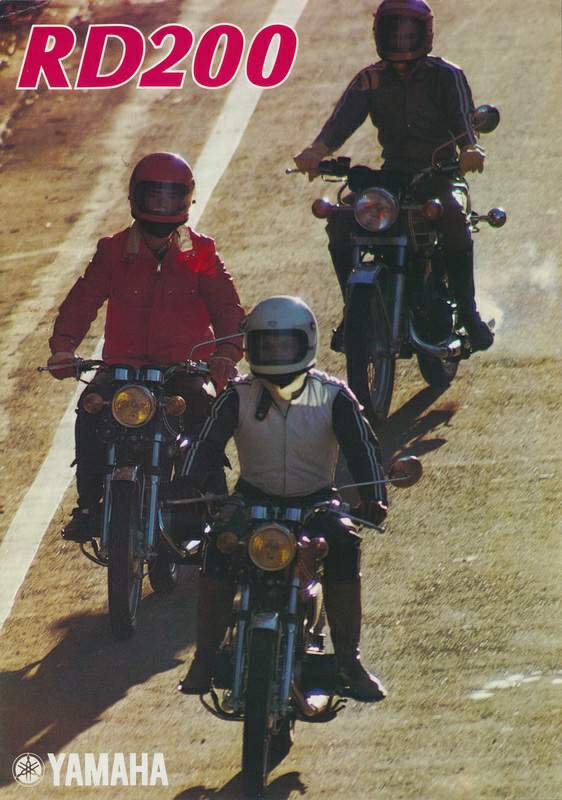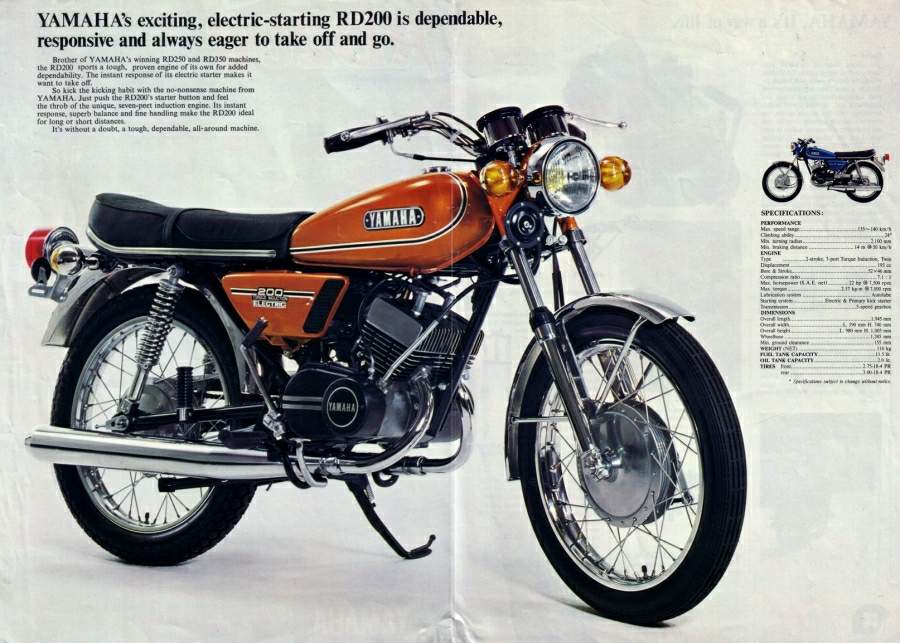|
Make Model |
Yamaha RD 200 |
|
Year |
1974 - 75 |
|
Engine |
Two stroke, torque induction, parallel twin |
|
Capacity |
195 cc / 11.8 cu-in |
| Bore x Stroke | 52 х 46 mm |
| Cooling System | Air cooled |
| Compression Ratio | 7.1:1 |
| Lubrication | Autolube |
| Oil Capacity | 1.2 L |
|
Induction |
2x Y20P Carburetors |
|
Ignition |
Battery coil |
| Starting | Electric & Kick |
|
Max Power |
20 hp / 14.7 kW @ 8000 rpm |
|
Max Torque |
1.9 kgf-m / 8.6 Nm @ 7000 rpm |
| Clutch | Wet multi-plate |
|
Transmission |
5 Speed |
| Final Drive | Chain |
|
Front Suspension |
Telescopic forks |
|
Rear Suspension |
Dual shocks |
|
Front Brakes |
Drum |
|
Rear Brakes |
Drum |
|
Front Tyre |
2.75-18-4PR |
|
Rear Tyre |
3.25-18-4PR |
| Dimensions |
Length 1945 mm / 76.5 in Width 755 mm / 29.7 in Height 980 mm / 38.5 in |
| Wheelbase | 1240 mm / 48.8 in |
| Seat Height | 780 mm / 30.7 in |
| Ground Clearance | 155 mm / 6.1 in |
|
Wet Weight |
140.0 kg / 308.6 lbs |
|
Fuel Capacity |
11.5 Litres / 3.0 US gal |
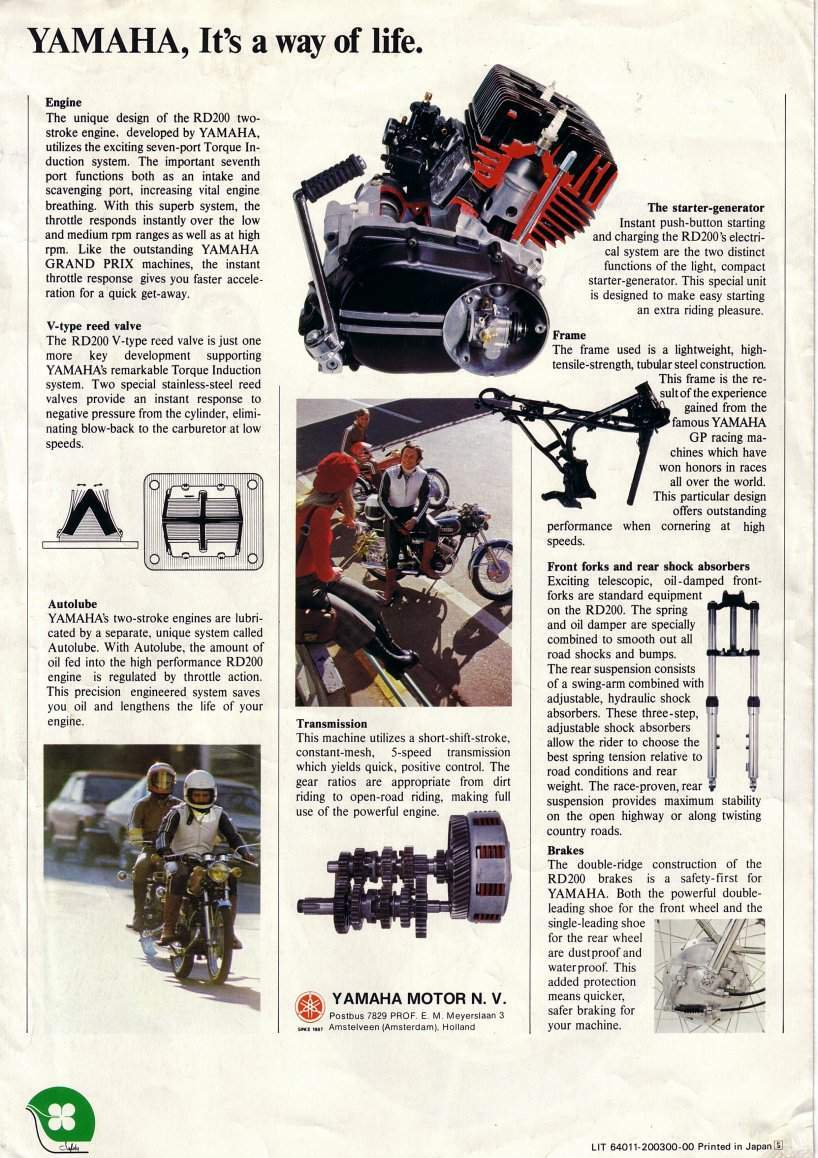
Motorcyclist Illustrated 1976
The path of progress is neither smooth nor straight. Indeed, as proved by that of the 200 Yam on this occasion it can prove to be most confoundedly awkWard.
For many years the little twin has been a performance leader in its class — and with good reason, for neither Honda's CB175 and CB200, nor Suzuki's 180 have the zippy urge of this little bundle. For all that, though, in contradiction to its elder brothers, the 250/350 (now 400) twins, there has been a certain laxity of purpose about the machine's chassis and its performance.
This is probably because it is, after all, little more than a 125 (to which it is manifestly related) stretched to its absolute extremes without positively exceeding them. The advantages of such a policy are numerous. For the manufacturer it allows for the sharing of design, development and production costs, and for the owner of the larger model it provides him with what might be termed a power-to-weight bonus over another similar sized machine owing no allegiance to a smaller flyweight, inasmuch as a considerable proportion of the major components involved with the "stretched" model are by their nature undersized rather than oversized.
The danger involved lies in the inability of these same "little" chassis to adequately substantiate the needs of the power unit. With a big, heavy motorcycle the dangers are very real as any rider of the old range of 500/650 British twins will readily admit; an extreme example of component sharing, sometimes almost pathological, to a degree that literally, only the pistons were different between the machines involved. In every case the 500 was the better motorcycle, apart from any other factors, because of the relatively unstressed and therefore better performing chassis involved.
In the case of small machines the position changes, primarily because without the high power and heavy weight needed to produce those same symptoms of stress, the overlap of engine power and chassis strength, while still apparent, does not produce the violent and therefore frightening reactions involved with the bigger stuff. Indeed, it might be claimed with some justification that a spot of instability on a lightweight tends to increase its attractiveness somewhat, thanks to the spirit of safe adventure it injects into what is, after all, frequently a rather boring strata of performance.
There are a very few extra special flyweights manufactured, however, of such rare quality that any intrusions contrary to the nature of the machine can only be resented for the manner in which they debase an otherwise flawless performance.
If an avenue of escape presents itself though, providing the adoption of the modification is convenient, there is little reason not to applaud the product, but when a needless and major change is made which virtually eliminates the possibility of improvement then the whole situation changes.
The Yamaha RD200 is very closely related to the RD125. The little bike exhibits all the stability and handling talents of a born racer which, strangely enough, it never was originally, unlike the bigger Yamaha strokers, but the 200 has always tended to lurch around a bit, something which has always been simple to resolve by either enjoying the impression it created of real racer skill and bravery in the minds of even the least imaginative riders, or to remove the touring type big handlebar latterly fitted by Yamaha, and replace it with a short, flat one.
This exercise shifted the rider's weight forward and therefore increased his damping effect on the front tyre; simultaneously the shorter handlebar reduced the effect of his reaction to wheel wobble on the wheel itself besides reducing its effect through the bar to him and thus ensured a more stable ride.
In order to appease their marketing experts, Yamaha have succumbed at last to the abominable attractions of disc brakes. So now adorning the front wheel of a previously perfect drum braking system is a hydraulic disc brake.
As has been said so many times previously in MCI, if there is one thing most roadsters do not need, especially lightweights and even more especially, flyweights, it's disc brakes, principally because they are not as efficient in the hands of 90 per cent of riders for 90 per cent of the time as drum brakes are. To Yamaha's credit, though, I must confess that of the Japanese manufacturers their disc brakes are noticeably best.
We therefore have the new situation involving the RD200 whereby it has positively undergone a retrogressive development step if it is judged in real terms of safe performance — and remember, there's a damn sight more to braking than stopping a wheel turning. So how does this involve stability, the point of the previous discussion? Simply, like this: Due to the bulk of highly specialised braking equipment required on the handlebar of a bike with a conventional hydraulic braking system, it is vital that either high or wide handlebars are adopted to ensure adequate clearance for the master cylinder and hose if they are not to crowd instrument mountings. No longer is it possible to conveniently exchange the big bar for a short, flat one which was able to contribute so valuably to the improvement of the 200's high speed stability.
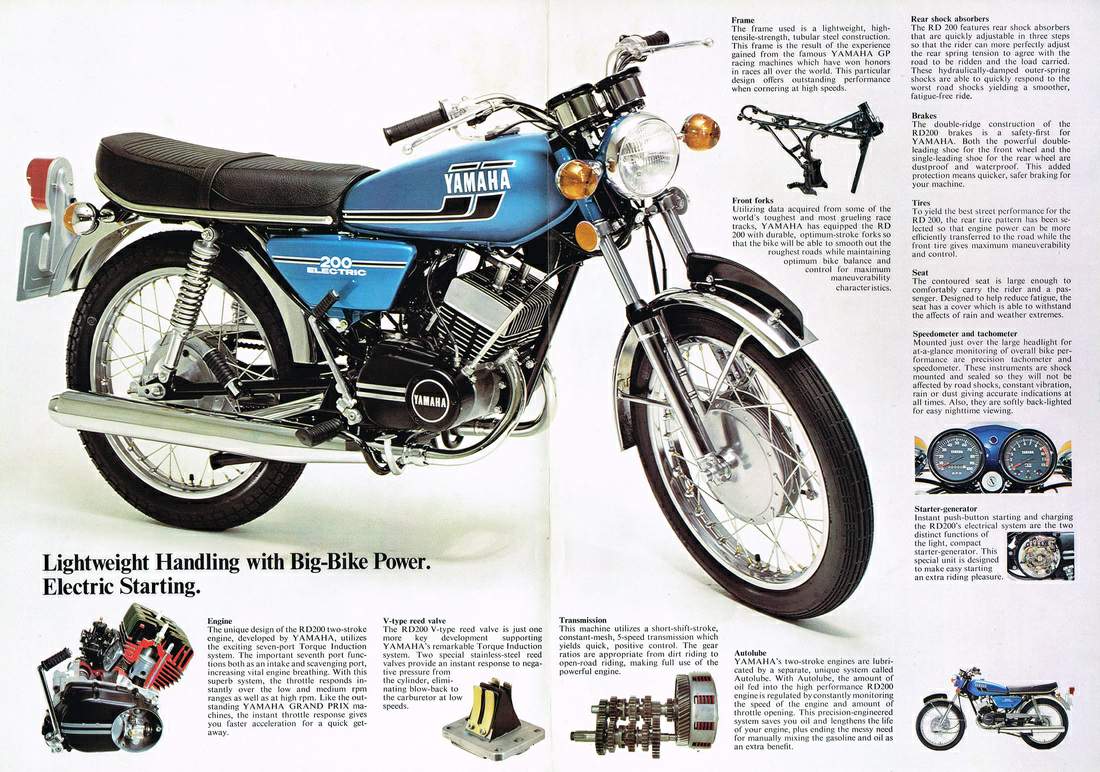
And so it is that, once more, for totally indefensible reasons, another little motorcycling gem loses its lustre. Paradoxical, isn't it, that the adoption of an hydraulic disc brake, ostensibly intended to improve performance, actually detracts not merely from that which it was designed to improve, but from what was probably the only area of another performance characteristic which could, perhaps, have done with a little help?
One of the two test machines I used had undergone a certain amount of attempted improvement by way of handlebar interchange, but the owner, Keith (many thanks to G&S Motorcycles of Leominster), was dissatisfied with the standard handlebar and the riding position it forced him into adopting which he felt was unsuited to the machine's true potential. He has so far been unable to find a handlebar which will fit without involving major brake system and instrument mounting modifications. The flat bar currently used puts the rider's weight in the right place, but so far apart does it force the arms that the inherent needle-sharp compactness of the machine is ruined. Such minor criticism can only be levelled at motorcycles of unusually good quality, for only on them do they stand out so obviously. Given a low powered engine, less attractive styling, or perhaps a utilitarian performance and finish in general, the 200, whatever its recent shortcomings, would not invoke in me the same strength of feeling for, apart from the items just mentioned, it still stands out a long way ahead of its contemporaries in the flyweight classes. As a matter of fact I prefer it to the RD250, logically a superior motorcycle by reason of its improved chassis and power unit performance, but there is something about the smaller twin that is particularly endearing. Exactly what it is I don't know, but I strongly suspect it comes from its light weight, almost total smoothness, light controls, responsiveness and sensitivity, and a power development out of all proportion to its capacity. The RD250 is expected to perform like a racer, after all it is pretty closely related to one, but this one is not and, despite great familiarity with it throughout the years, each time I ride one I am freshly surprised, even amazed by it.
Top speed, for instance, proved to be almost 90mph (149km/h)! And just remember, we are discussing a 195cc motorcycle after all. As always I am puzzled by the odd claims of the factory regarding its power development which dictate that 22bhp at 7500rpm should produce optimum results. It doesn't by a long chalk, for both these figures should * by rights limit top speed to 75mph (120km/h) whereas in reality there is another ten mph at the very least on tap, during which running period the engine spins happily through another 1000 revs in top gear and 1500 in the intermediates, placing top bhp maximum at around 9500 revs.
Yamaha also claim that maximum torque arrives at 7000 revs. Hmm ... I will admit that despite the commend-ably torquey low and medium power development available from the reed valve induced engine it could be higher than that. If both figures were lifted by 1000 revs from their present then I might believe them.
Not that I am grumbling mind. Despite the high maxima the lower ones reach down a long way, road speeds as low as 25mph (40km/h) in top gear proving to be totally practical during city commuting runs when cog-swapping is always something of a bind on a sporty machine. And what is more, that engine would find enough power from somewhere down in its steely little guts to accelerate from that speed, if not briskly, at least usefully. Not until 4000 revs did acceleration in top gear become truly hard, but over that band it required a very steep hill to slow it, even with a pillion passenger.
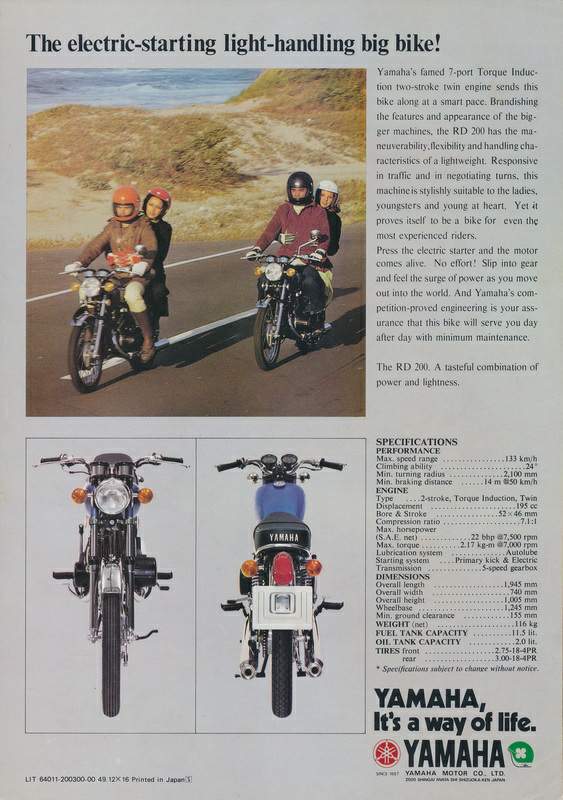
At 6500 revs (65mph - 140km/h) it seemed that everything had really slotted in and the power hit a magnificent increase which, I must confess, encouraged me to more often than not play around that engine speed, up and down the gearbox, in order to enjoy the experience to its utmost, and during which time I must further confess to ignoring the clutch on occasion for the delight of shifting through an almost perfectly designed box and matching ratios. My pleasure was increased further by the delight I found in using a five speed gearbox, my fear being that the 200 had succumbed to the moronic adoption of what is fast becoming a universally accepted standard of six gears. On the old Suzuki Super Six, when it was the only bike so equipped, this was fine and dandy, but the slavish copying of a totally impractical, wearying transmission type with so many ratios reeks of madness. The 200's five covered all situations superbly, being low enough to deal with the most restricting traffic jams, spaced to overlap each other's engine power development band, yet high enough to provide not simply a decent cruising speed, but a true maximum road speed as well, limited only at the far extremes by engine speed.
Interestingly enough road speed in fourth gear (8.30:1) proved to further establish my claims of a wide power spread, and a well chosen set of ratios. With a pillion passenger up behind, top speed was limited to a fifth gear maximum of around 77mph (124km/h) (7700rpm), but in fourth gear, although not actually increasing speed by much (80mph/129km/h) those extra 1300 revs provided a much more tenacious speed.
Unlike so many two strokes, this one did not manufacture a lot of induction noise. Without that wearing howl so commonplace on a lot of strokers, without a single tremor of vibration anywhere in the speed range and with a wide spread of power, very comfortable smooth suspension, and such simple gear changing, the wee Yam is very apparently one of those little wonders that really can be all things to all (lightweight) men. Taken a stage further, I suggest it is even better suited to lady riders, most of whom sensibly abhor so many of the things that once (or so it would appear from the reaction of collectors these days) made our own industry great.
There are very few two strokes indeed that appeal to me, but this is one of them. Perhaps my only criticism lies with the fuel consumption, which most certainly does not bear comparison with the similarly sized Hondas. The best possible obtained from the RD200 was 56mpg, and that involved a style of riding more usually associated with district nurses on their rounds. The average finalised to an all round mean of 43mpg, but admittedly it was pretty fast riding. Worst was a speed test run of only 35mpg, but as the engine is such a small one, perhaps it should be seriously considered, as small engines are so easily maximised. The average excluding speed test rides was 46mpg.
Lastly — finish. As with most Yamaha's it was impeccable. Exactly which motorcycle can make claim to being the best I don't know, put paintwork, chrome, casting quality, lining, instrumentation, switchgear etc, were all of the highest quality and must rank, as do most Yamahas, as very close to top.
Yamahas, might cost a little more than other Japanese makes, but they are probably the best engineered of them all and the RD200 is typical of the marque.
The lights were excellent for the size and speed of the machine they had to contend with, but most of all, even on this diminutive power unit, I enjoyed the electric starter.
Owing to the total lack of rain countrywide in August the tyres could not be fully analysed but they provided a stable, yet sensitive, ride in dry weather.
If someone said to me (now that the small desmo Ducati’s are out of production) I had to limit my riding to 250cc maximum, I'd be hard put to find a better one than this to choose.
